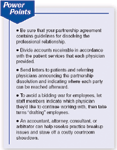Article
Group practice: Breaking up is hard to do
Close business relationships, like marriages, can end acrimoniously. Here's how to avoid the pain.
Twelve years ago, FP John Machata of North Kingston, RI, entered into a partnership with another family physician and an internist. "We set up a walk-in clinic," he says. "But despite my insistence that we formalize the relationship, it never happened. After a year we became profitable, and I was forced out. It took six years of legal wrangling for me to recover my investment."
FP Barbara Canfield (not her real name) worked with a mismatched partner for 13 years before calling it quits. "It had long been obvious that our practice styles were incompatible," Canfield says. "She spent a lot of time in the exam room, and tended to attract patients who were emotionally needy. Her income reflected that style. Not only were her charges way lower than mine, I subsidized her income every year-sometimes by as much as $15,000. When she finally left, she took all of her assets but assumed no responsibility for the practice liabilities. I ended up using my own money to refinance the mortgage on the building we owned. My attorney and accountant thought I was nuts, but I just wanted it over."

Of course, terminating a partnership need not be acrimonious-if, for instance, it's ending because one of the physicians wants to move, retire, or make a career change-and there's a written agreement that spells out how things will be handled. That agreement should go into effect on Day One of the partnership and it should specify how the enterprise will be structured, how it will function, and what will happen if it disbands.
Here's how to handle five key breakup issues:
1. Dividing assets and liabilities. "Optimally, when a partnership ends all debts are paid and the partners split any remaining assets," says Will Latham of the Latham Consulting Group in Charlotte. "If any debt remains, each partner assumes a piece of it. Sometimes it may be necessary for the physicians to borrow money to pay off creditors."
In a two-doctor breakup, asset division will depend on whether one party wants to maintain the same space, says Geoffrey T. Anders, an attorney and consultant with The Health Care Group in Plymouth Meeting, PA. In that case, Dr. A might offer a certain amount for Dr. B's share of the practice, including the hard assets, telephone system, computers, office lease, and so forth. Dr. B can either accept, ask for more money, or make his own buyout offer. If no one's keeping the space, assets typically are divvied up and then appraised, with the difference in value paid off in cash. So if Dr. A winds up with items worth $75,000 and Dr. B's share is worth $50,000, B owes A $12,500-half the difference.





